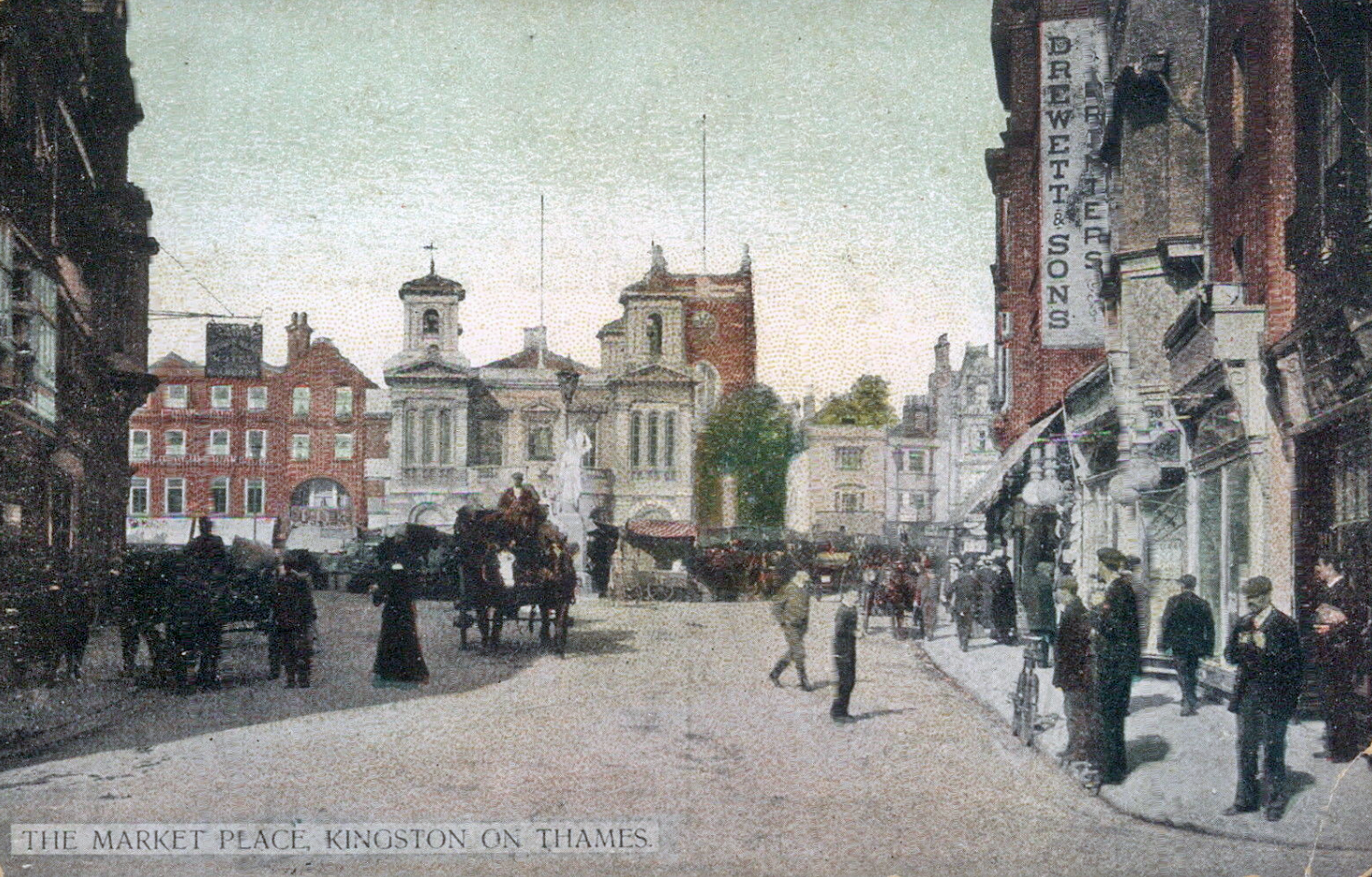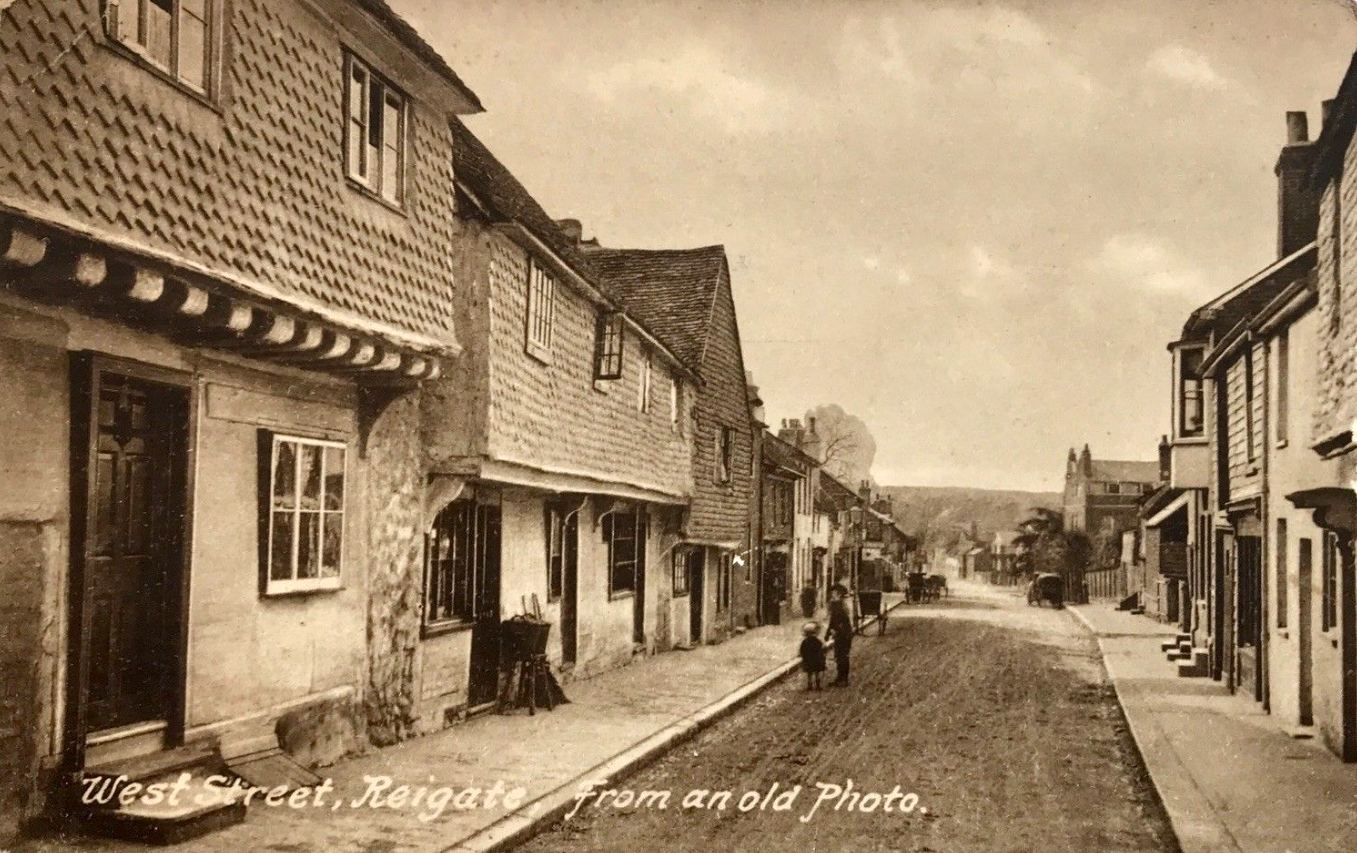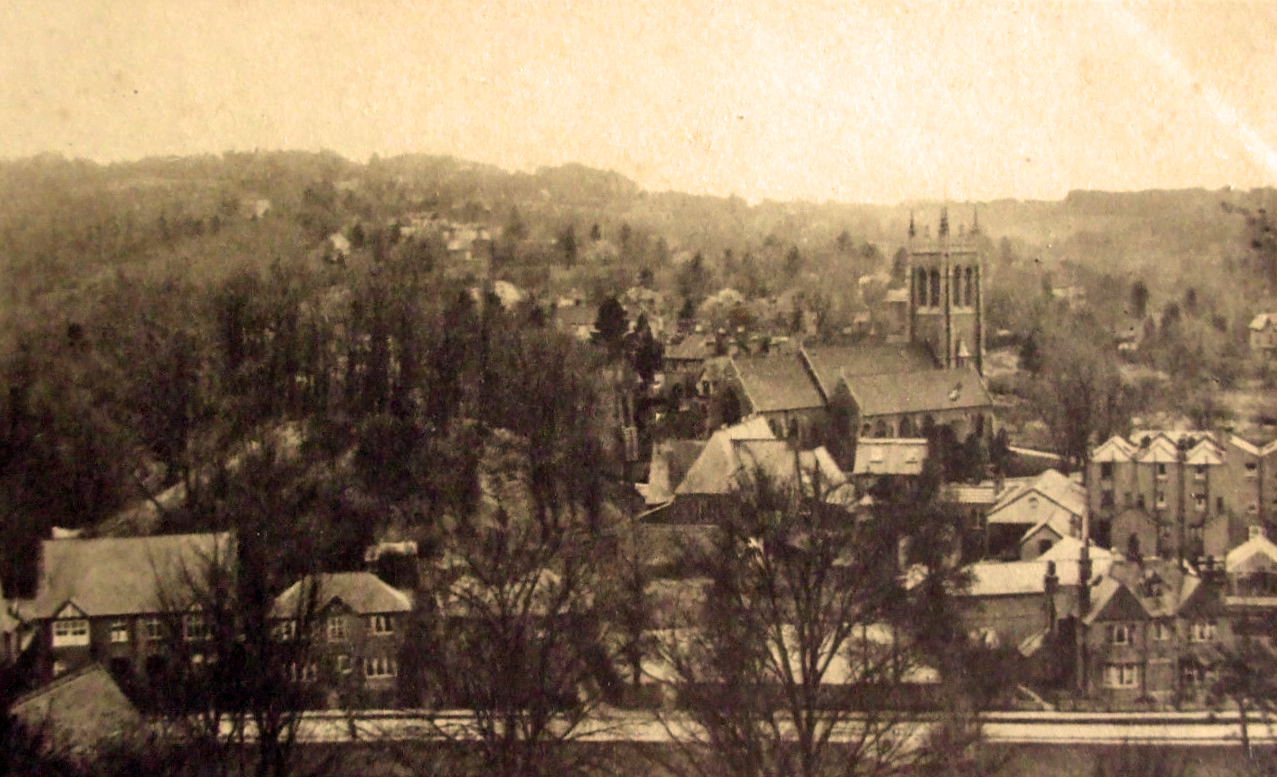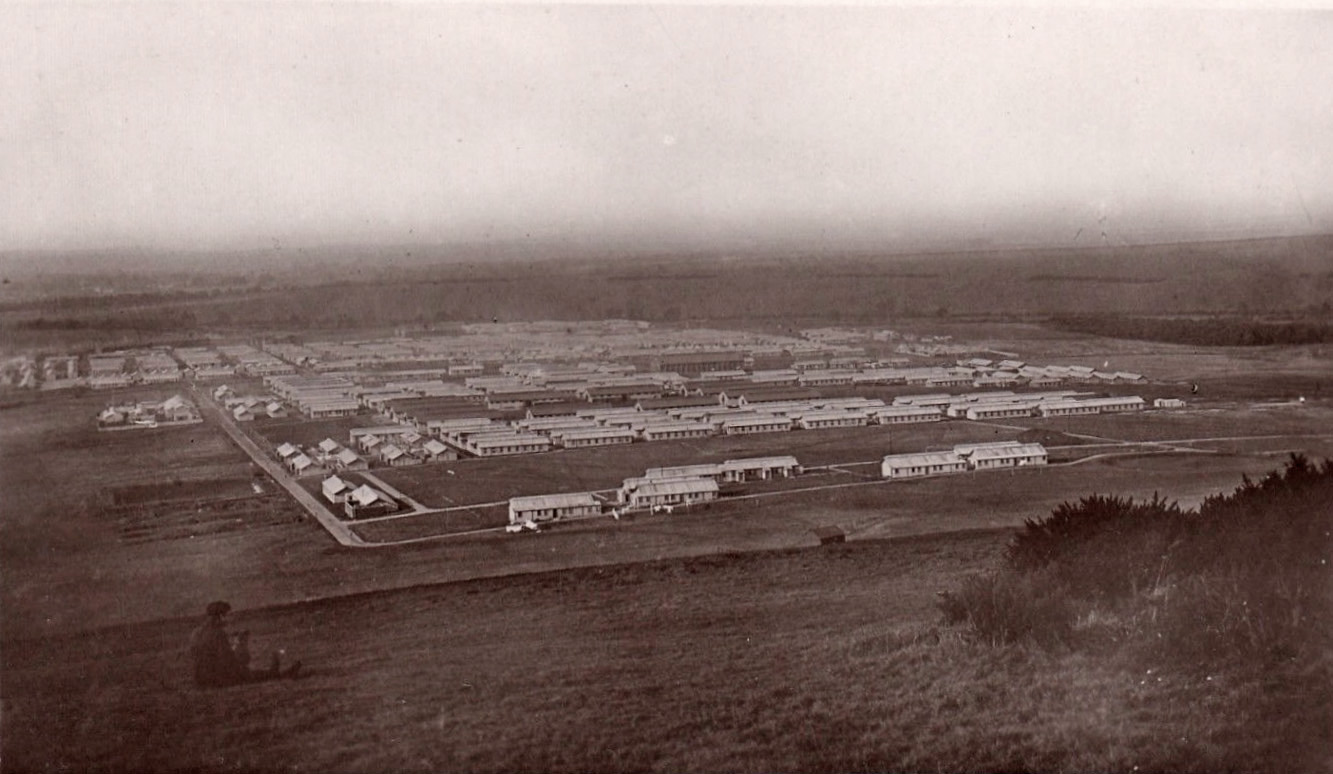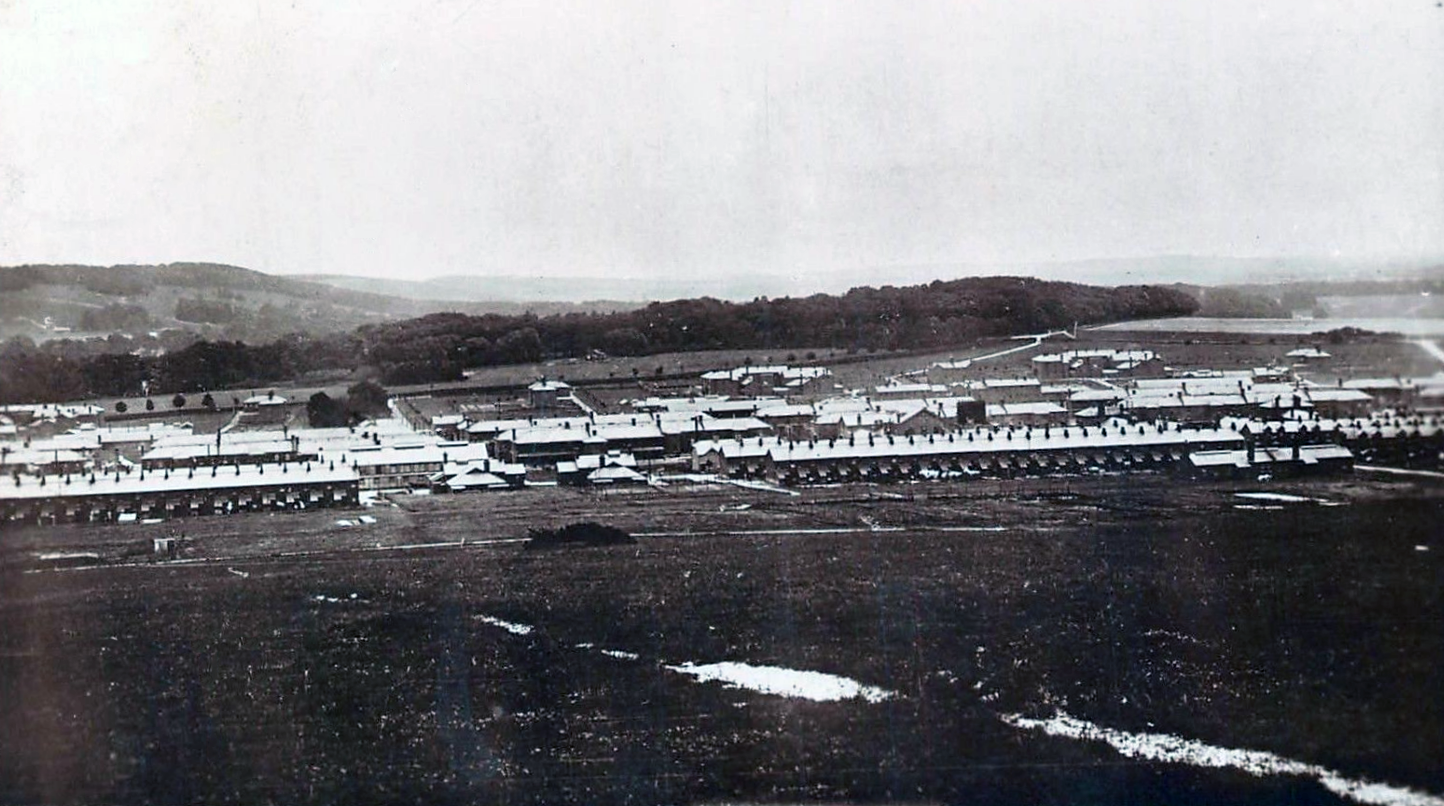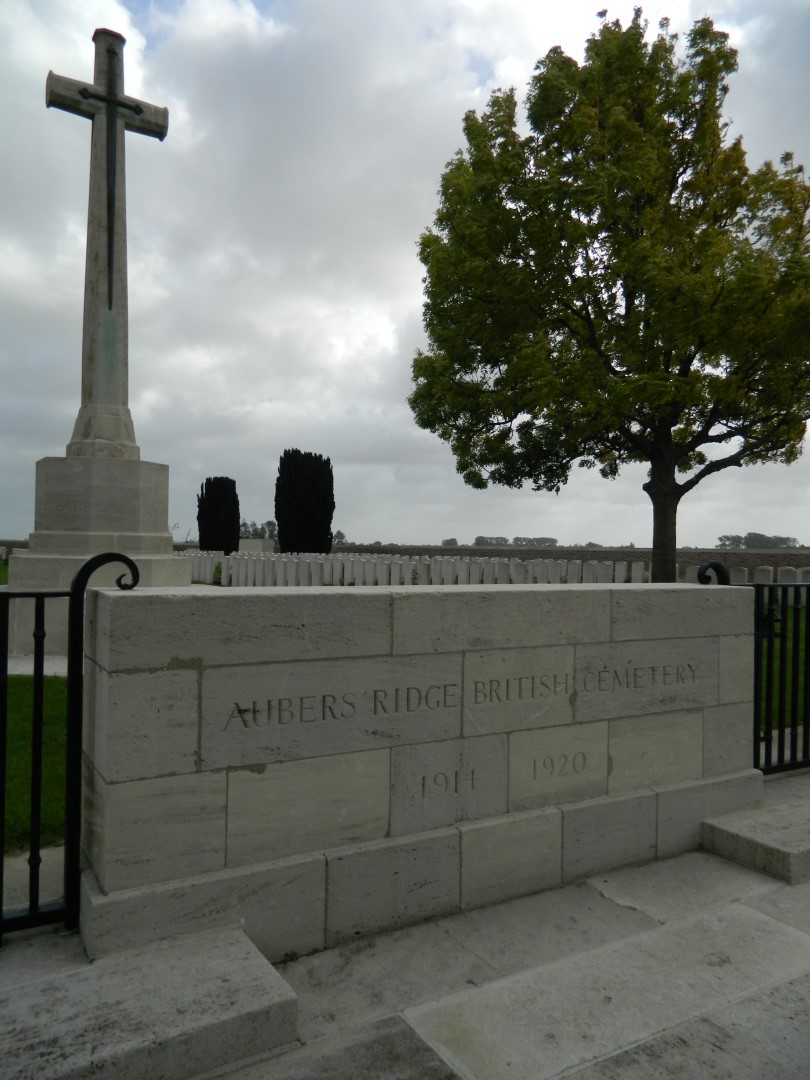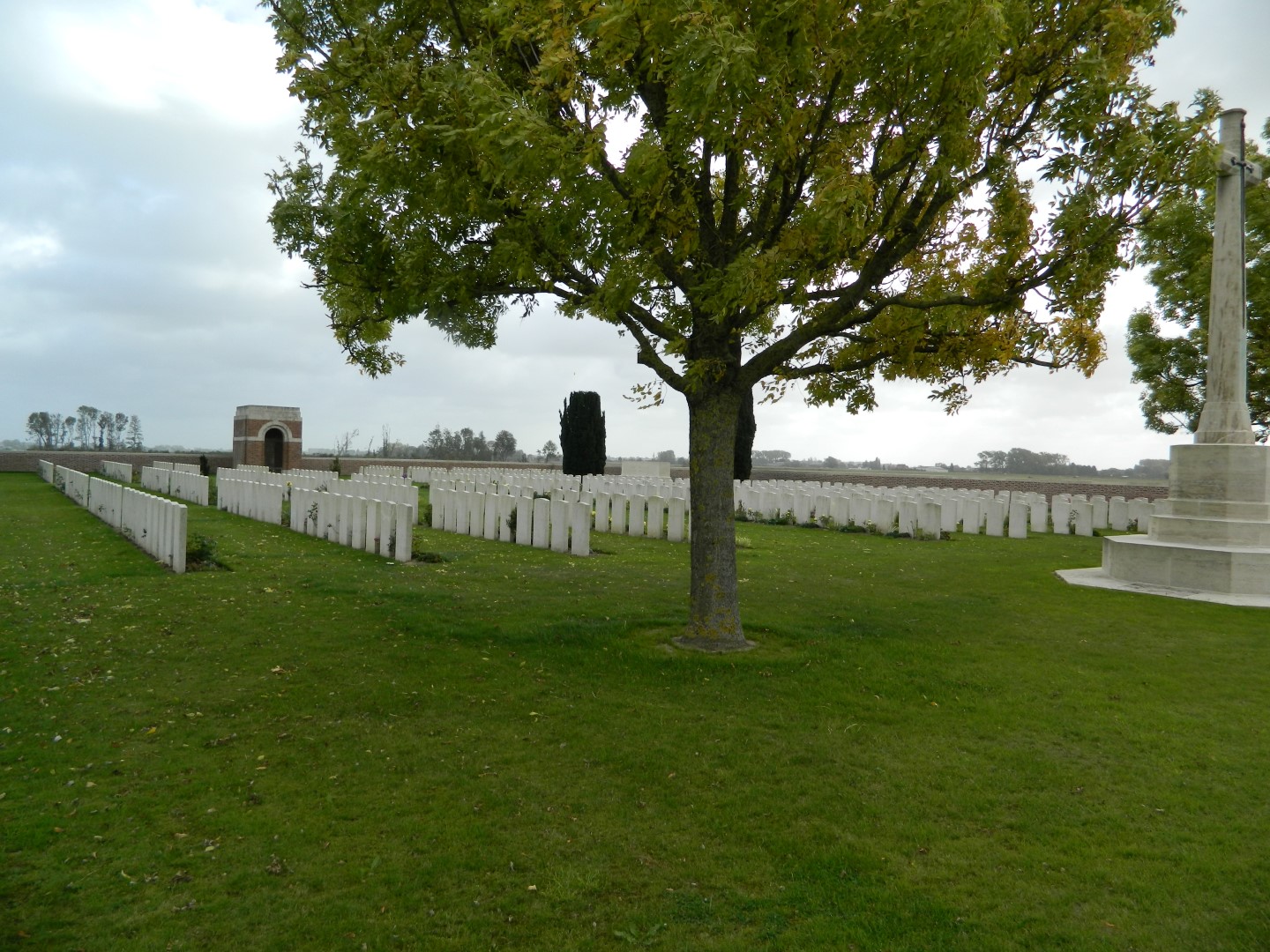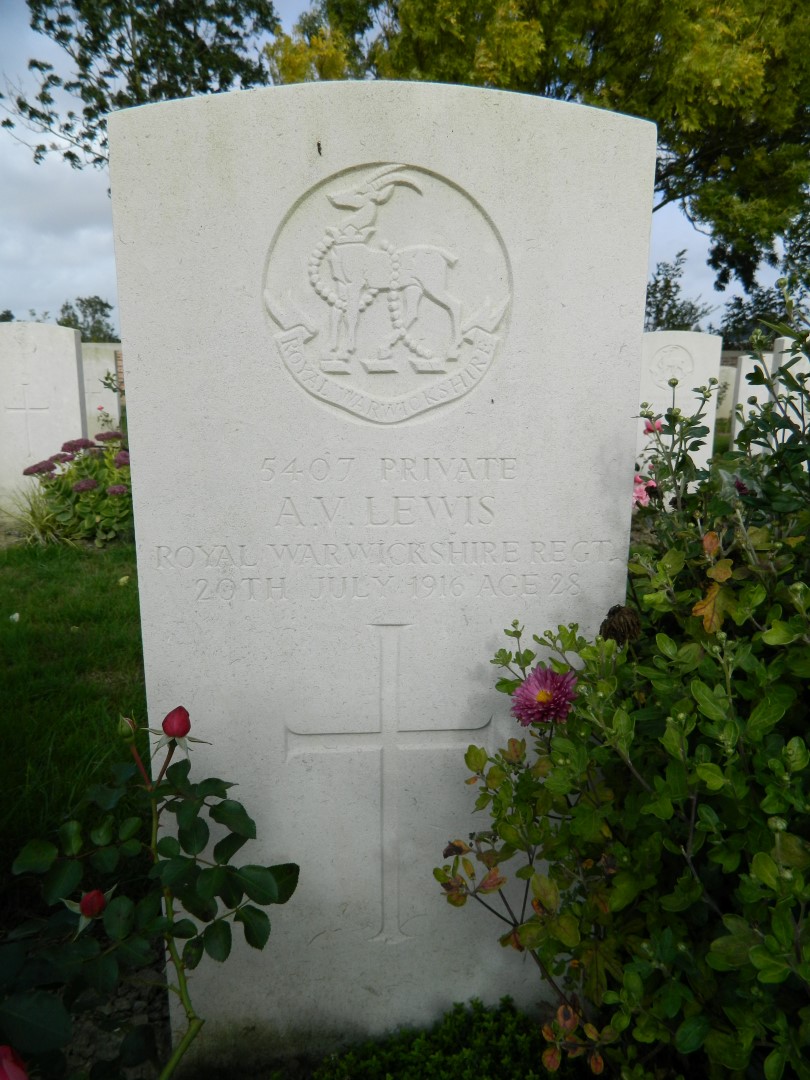Albert Victor Lewis
Private Albert Victor Lewis of the Royal Warwickshire Regiment, 2/8th Battalion (Formerly 2179 Hampshire Rgt.) was killed in action on the 20th July 1916, aged 28.1
Early Life
Born on 14th March 18872 in Kingston upon Thames, Albert’s home and immediate family background in his early years were probably the envy of his young friends: the family owned and ran a toy and games shop in the town. His father, William Henry,3 had learned the retail trade while lodging with and working for his German uncle, John Shuler, who owned a British and Foreign Fancy Goods shop in Reigate High Street.
Kingston upon Thames, late 19th Century. The family shop was behind the camera to the left. Public Domain
William’s shop, at 58 and 60 Kingston High Street4 was also the family home. He married Sophia Anna Spence, a schoolmaster’s daughter, in 1882. Three children were born to them: Antonia Gertrude (1883),5 William John Ackfield (1884)6 and Albert Victor (14th March 1887). In Albert’s early years, the household also included Sophia’s widowed mother Antonia who died in November 1892 aged 88.
It would seem that Albert’s family laid claim to grander connections too. Antonia’s late husband, Albert’s grandfather, Thomas Spence (1797-1875) was a tailor in Throgmorton Street, London, and was granted the Freedom of the City on 28th December 1839. A newspaper article7 also reports that Albert’s great grandfather was Admiral Vincent,8 and his uncle was Sir Edward William Brabrook C.B. (1839–1930).9 In both these latter cases no link has yet been found to Albert’s known ancestry.
Public domain.
By 1901, the family had moved from Kingston to Reigate where Albert completed his primary education, at St. Mark’s School. This was a mixed, National school in Holmesdale Road, built in 1869, for 300 pupils. The junior school had an average attendance of 168 boys and girls and the Master was 49 year-old William Punton.
Albert had evidently set his heart on teaching as a career. We know from his later college record that he worked as a pupil-teacher and then assistant teacher before training—quite in keeping with practice of the time. This route had also been taken by his older sister Antonia, working as a pupil-teacher at St. John’s School, Caterham. What is unusual is to find that he spent time at grammar school in between his primary education and becoming a pupil-teacher. While at St. Mark’s School, he won a scholarship to Reigate Grammar School, where he studied from 1902–1903. On leaving the grammar school it is not known where he worked as a pupil-teacher as his college record is mute on the subject, recording only a tick. Many prospective teachers began their classroom experience in their old primary school, so it is possible that he had returned there. He was later appointed as an assistant teacher at St. John’s School, Caterham Valley.
St John’s Church, Caterham Valley. From 1920, the scene remains largely as it was then (with the exception of the houses in the immediate foreground on Crescent Road). The school buildings are next to the nearest (NE) corner of the church. Public Domain
There are some years unaccounted for in his records. He had worked as a pupil-teacher from 1903 and, at the latest, this would have taken him to the summer following his eighteenth birthday (1905). As he did not begin his course at Winchester until September 1913, there is an eight year gap and only the assistantship of four years at St. John’s School to fill it. Perhaps the most likely conjecture—concordant with the histories of the other college entrants of the period—is that following his pupil-teacher time there was a promotion to an unrecorded initial assistantship at the same school. The St. John’s assistantship followed this and took him up to his entrance to college. The family’s 1911 census return records him as a teacher in the pay of the Borough Council. The school is unspecified. Press obituaries in 1916 only mention his connection with St. John’s School.
During this period as an assistant teacher, he studied in his own time and gained examination passes in Botany and Hygiene, and Model and Freehand Drawing. He also gained the Surrey Education Committee’s Physical Training Certificate. However, the major qualification was quite a feather in his cap: he took the Oxford Senior Entrance Exam in 1907 in which he was awarded a First Division pass.10
The 1911 Census return also shows us that his father, William, was no longer present. He had died in the summer of 1907. His older brother William was a Post Office clerk, his mother Antonia is a widower and the form has been completed by his sister Antonia.
Albert in Winchester
Albert had entered Winchester Training College in September 1913 on the two-year course. War would intervene and he would only complete his first year. Little is said of his time there although the student magazine, The Wintonian, records that he was a bridge player—one of the indoor ‘sports’ organised by the student body: ‘In the Open Bridge Competition Albert Lewis and his partner Paice, were defeated in the final by Hart and H W Rose.’ Edward Clifford Frank Hart and Harold Walter Rose were also to die in the Great War during 1916, both in Mesopotamia.
Unfortunately the Mark Book recording the 1913-1914 academic year did not survive and so we do not know anything of the academic side of Albert’s life. His Oxford Seniors results would suggest that he would have been among the highest preforming students.
The Outbreak of War
Albert’s main Army records were destroyed during the Blitz in the Second World War. There are some documents (Medal Roll and Index card, Commonwealth War Graves records, Soldiers effects ledger) which give some basic information, allowing some reconstruction of his war story.
The first waymark is that his family, on his death, were awarded his Service Gratuity of £9 0s 0d. The size of this payment is related to the length of his Army service to the date of death, indicating Albert was deemed to have enlisted in August 1914. For the circumstances surrounding his enlistment we need to return to events at college.
Bulford Camp, Salisbury Plain. Public Domain
Alongside their studies and social life, almost all students enlisted in the 4th Battalion Territorial Force of the Hampshire Regiment. As the academic year came to a close in the summer of 1914, these men left for the annual territorials summer training camp which had been arranged on Salisbury Plain at Bulford Camp, Sling Plantation and Bustard Camp, from 25th July to 4th August 1914. Following the declaration of war they were immediately mobilised. Territorial soldiers could only be stationed within the United Kingdom unless they voluntarily agreed to serve overseas. They would signal this agreement by signing an Imperial Service Obligation (Army Form E624). Students that did so were sent to fight abroad: those transferred to the 1/4th Battalion left for Poona, India on the 9th October, followed by those allocated to the 2/4th Battalion who left for Quetta, India, now modern-day Pakistan, on 12th December. Albert had elected, with some others, to remain as territorials for the time being.
As for the handful of students (six of the eighty in training in the 1913-1914 academic year)11 who were not territorials, they would resume their studies in September but at Bede College, Durham, not Winchester. The college had closed for the duration of the war and would not open again until 1919.
The Great War
Private Albert Victor Lewis was home (i.e. U.K.) based until mid-1916. It is highly likely that his service through this time closely followed that of fellow 1913-1915 student Merton Rose. This would place him probably in the 84th Provisional Battalion, more commonly known as the 2/6th (Duke of Connaught’s) Battalion of the Hampshire Regiment. Although the exact whereabouts and responsibilities of this unit are not known, in February 1916 it was stationed at Blyth, on the Northumberland Coast, suggesting coastal defence was one of his duties. The Battalion had been in the Northeast at least since October 1915 as they are reported in the Newcastle Journal as competing in an inter-battalion cross country race.12 From other histories, postings of this battalion through this period include Petersfield, Bournemouth and Hursley Park.
Tidworth Camp. Public Domain
Again, assuming the link with Rose is correct, a transfer in February in 1916 to the 3/16th Battalion London Regiment would have followed. This unit had just moved from Richmond to Winchester, bringing Albert back to his old haunts. In April the Battalion name was changed from 3/16th to simply to 16th Battalion London Regiment. The barracks were at Tidworth/Perham Down on the Hampshire/Wiltshire border. He was transferred to the 2/8th Battalion Royal Warwickshire Regiment on 16th May. And on the morning of Sunday, May 22nd 1916, the Battalion left their camp at Perham Down in Wiltshire, marching the short distance to entrain at Ludgershall station, en route to Southampton. As Albert began his journey to the Western Front, it is comforting to know that he would be with friends: fellow WTC students Merton Rose and Joseph Sharp were also making the same journey. All three had overlapped at college in the 1913-1914 academic year. At 7pm, 23 Officers, 855 Other Ranks boarded the paddle steamer Princess Clementine at Southampton Dock, bound for Le Havre, landing there the next morning at 3am. They had landed in France as part of the 182nd (2nd Warwickshire) Brigade in the 61st (2nd South Midland) Division, heading into the conflict.
The Battalion travelled 150 miles to L’Ecleme by train. Here, encamped 5 miles northwest of Béthune, they trained and drilled and, through most of July, the men would be in trenches in the Neuve Chapelle sector, close to the France–Belgium border. Towards the end of the month, they would see their first action nearby, in the Battle of Fromelles. The Division was paired with the 5th Australians, both of whom were untried in battle yet were required to provide a major diversionary attack to draw enemy troops and resources away from the Somme. The enemy had had considerable time to establish strong defensive positions and as a result the British and Australians suffered heavy losses. Month-end casualty totals are not given in the Battalion War Diary, so losses are difficult to quantify.
In the battle, Albert and the 2/8th Warwickshires were held in reserve, with the 2/6th and 2/7th Warwickshires on the front line in the Fauquissart section of trenches, where no man’s land was moderately wide (approximately 300 yards). The ground was soft with many drainage ditches, making movement difficult. The Germans had placed machine guns to cover the exit points from the British trench system, making it virtually impossible to attack without a high rate of casualties as the men went over the top at Zero Hour—11am on July 19th.
8 Section Panorama Western Front. FIELD OF VIEW: Aubers Ridge. DIRECTION OF VIEW: East South East to South East. CAMERA LOCATION: Through gap in tiles of house roof in Fauquissart. Copyright Imperial War Museum © IWM (Q 44542) Note trenches marked by sandbags.
At 8.30pm, Albert and his Battalion were ordered to move up to relieve the badly depleted 2/6th and 2/7th. They arrived in the front-line trenches at 11pm and the relief was completed by 12.50am on the 20th. Some measure of the intensity of the action even at this late stage in the attack can be understood from the fact that 7 of the relieving 2/8th men suffered from shell shock during the advance to the front-line trenches and the hand-over.
The Battalion War Diary for the 20th July is sparse, with nothing recorded for the 18 hours following the relief. As darkness fell, parties were sent out into no-man’s land to recover killed and wounded—a task that would continue for the next three nights. During daylight on the 22nd a party went out to recover the last of the wounded, 60 hours or so on from the start of the battle.13 On that first night it simply records ‘Many bodies buried.’
The time and day of Albert’s death is not known. There were casualties in the 2/8th during the relief and from that point onwards. His death date is officially recorded by the Commonwealth War Graves Commission and his Soldiers Effects ledger as 20th July—the official date of his death. Earlier records such as information from the family,14 his Aubers Ridge Grave Registration Form, and a grave exhumation record15 indicate 19th July, i.e. during the front-line relief.
Albert’s body was exhumed from its location near Fauquissart and reinterred at the Aubers Ridge British Cemetery on 4th March 1920.
Postscript
Casualty lists in the Surrey Mirror of 29 August and 1st September 1916 and the Dorking and Leatherhead Advertiser of 2nd September list him as King’s Royal Regiment but there is no other evidence for this connection. These reports are likely to be from a single syndicated source rather than independent and corroborative.
There is a report in the Surrey Mirror of Friday 4th August 1916, carrying news of Albert’s death, that his brother had been killed earlier in the war. This would appear not to be the case. His only brother, William John Ackland Lewis, served in the Royal Engineers as a telegraphist, enlisting on 16th December 1914 in Liverpool. He served in Gallipoli and Egypt before being evacuated to Britain by hospital ship on 21st September 1915, suffering from enteric fever. He made a full recovery and went on to serve until the end of the war, being discharged on 29th April 1919 and dying in 1956. Albert had no other brother. His brother-in-law served in the 8th Battalion East Kent Regiment (The Buffs), at home from November 1914 to September 1915 before being sent to France. He served there for one month before becoming a prisoner of war, a report being sent to his family in late October to say that he was wounded and in a German hospital. He was liberated in December 1918, discharged from the Army in 1919 and died in 1976. Finally, a memorial insertion on the anniversary of Albert’s death, carried in the Surrey Mirror on Friday 27th July 1917, ends with the words, From his sorrowing mother, sister and brother.’
Researcher and Author: John Westwood. Revised with additional material by John Vickers.
Aubers Ridge British Cemetery photos taken by Pat Naylor and Peter Lidgitt
Footnotes
[1] Although there is some uncertainty about his date of birth (see below) he was likely to have been 29 at death. The figure of 28 is carried in all his military sources.
[2] This the date of birth given in his college record. His entry in the Registrar’s Birth Index is for the following quarter (April to June 1887)
[3] Born in 1860 in Falmouth, Cornwall to coastguard William Ackland Lewis (b.1821, Harwich, Essex)
[4] ‘Fancy repository’ with premises also at 26 Thames Street (Kelly’s 1891 Surrey Directory, p.1355)
[5] Born 28th March 1883 in Kingston, died July 1977 in Reigate. She became a teacher and married George Henry Froud (Electrical Engineer, b.1891 Chelmsford, married 27th November 1891 Reigate, died 16th October 1976 Reigate)
[6] Born 16th April 1884 Kingston, died 17th September 1956 Windsor. Married Louisa Elizabeth Longman (b. 12th April 1899 Watford, m. 1925 Watford, d. 25th August 1946 Old Windsor)
[7] A report of Albert’s death in the Surrey Mirror of Friday 11th August 1916, page 1.
[8] Searches have failed to identify a suitable candidate among the four British Admirals who carried the name Vincent. The best match is that of Nicholas Vincent (1723?-1809, Admiral 1794 on) but the dates are unconvincingly early.
[9] Barrister, civil servant, author and anthropologist. He had a special interest in folklore and was a member of the Folklore Society and a fellow of Society of Antiquaries of London. His main life’s work was as senior registrar of friendly societies. He was responsible for the introduction of regulation of working-class self-help institutions, and promoted legislation for industrial and provident (co-operative) societies, trade unions, and savings banks—the forerunners of building societies. Much of his interest in encouraging and safeguarding this sector was inspired by his practising Methodist background. He was appointed a Companion of the Order of the Bath in the 1897 Diamond Jubilee Honours and knighted in 1905.
[10] Surrey Mirror Friday 23 August 1907, p.2
[11] Boyd, Michael V. (1981) The church colleges 1890-1944,with special reference to the church of England colleges and the role of the national society, Durham theses, Durham University. Available at Durham E-Theses Online: http://etheses.dur.ac.uk/7517/
[12] Newcastle Journal, Monday 11 October 1915, p.9
[13] Often the cries of wounded from no-man’s land had a terrible effect on the nerves of the front-line trenches and recovery was as much about maintaining the morale and effectiveness of the troops as it was compassion, humanity and bravery.
[14] Surrey Mirror Friday 11 August 1916, p.1. It is assumed that this information was given to the newspaper by the family as other details it contains would not have been known to the military authorities.
[15] The original grave, marked by a wooden cross, was given as map reference M.18.d.8.3. This lies in a field at a point 225 yards on a bearing 048 from the crossroads in the centre of the hamlet of Fauquissart. (Initial grave location 50°36’38N 2°48’00E). This site should not be confused with the small war cemetery at the other end of the hamlet.
Sources
Ancestry (2018). Home page. [online] Available at: www.ancestry.co.uk [Accessed 2018].
Boyd, Michael V. (1981) The church colleges 1890-1944,with special reference to the church of England colleges and the role of the national society, Durham theses, Durham University. Available at Durham E-Theses Online: http://etheses.dur.ac.uk/7517/
Britishnewspaperarchive.co.uk. (2019). Register | British Newspaper Archive, Dorking and Leatherhead Advertiser 2nd September 1916. [online] Available at: https://www.britishnewspaperarchive.co.uk/viewer/bl/0000867/19160902/158/0006 [Accessed 20 May 2019].
Britishnewspaperarchive.co.uk. (2019). Register | British Newspaper Archive, Newcastle Journal Monday 11 October 1915. [online] Available at: https://www.britishnewspaperarchive.co.uk/viewer/bl/0000569/19151011/062/0009 [Accessed 20 May 2019].
Britishnewspaperarchive.co.uk. (2019). Register | British Newspaper Archive, Surrey Mirror 1st September 1916. [online] Available at: https://www.britishnewspaperarchive.co.uk/viewer/bl/0000335/19160901/213/0009 [Accessed 20 May 2019].
Britishnewspaperarchive.co.uk. (2019). Register | British Newspaper Archive, Surrey Mirror 29 August 1916. [online] Available at: https://www.britishnewspaperarchive.co.uk/viewer/bl/0000335/19160829/061/0003 [Accessed 20 May 2019].
Britishnewspaperarchive.co.uk. (2019). Register | British Newspaper Archive, Surrey Mirror Friday 11 August 1916. [online] Available at: https://www.britishnewspaperarchive.co.uk/viewer/bl/0000335/19160811/002/0001 [Accessed 20 May 2019].
Britishnewspaperarchive.co.uk. (2019). Register | British Newspaper Archive, Surrey Mirror Friday 23 August 1907. [online] Available at: https://www.britishnewspaperarchive.co.uk/viewer/bl/0000335/19070823/001/0002 [Accessed 20 May 2019].
Britishnewspaperarchive.co.uk. (2019). Register | British Newspaper Archive, Surrey Mirror Friday 27 July 1917. [online] Available at: https://www.britishnewspaperarchive.co.uk/viewer/bl/0000335/19170727/002/0001 [Accessed 20 May 2019].
Commonwealth War Graves Commission, (2018). Home page. [online] Available at www.cwgc.org/ [Accessed 2018].
Great War Forum, (2018). Home page. [online] Available at: www.greatwarforum.org [Accessed 2018].
Imperial War Museums. (2019). Photograph, 8 section panorama Western Front. Field of view: Aubers Ridge. [online] Available at: https://www.iwm.org.uk/collections/item/object/205278887 [Accessed 20 May 2019].
The Long Long Trail, (2018). Welcome to the long long trail. [online] Available at: http://www.longlongtrail.co.uk/ [Accessed 2018].
The National Library of Scotland (2018). British Forst World War Trench Maps, 1915-1918. [online] Available at: https://maps.nls.uk/ww1/trenches/index.html [Accessed 2018].
Rose, M. (1981). A history of King Alfred’s College, Winchester 1840-1980. London: Phillimore.
Specialcollections.le.ac.uk. (2019). Kelly’s Directory of Kent, Surrey & Sussex, 1891. [Part 3: Surrey] – Page 1355. [online] Available at: http://specialcollections.le.ac.uk/digital/collection/p16445coll4/id/187260 [Accessed 20 May 2019].
Vickers, J. University of Winchester Chapel Memorial Rail image.
| University of Winchester Archive “ Hampshire Record Office | ||
| Reference code | Record | |
| 47M91W/ | P2/4 | The Wintonian 1899-1900 |
| 47M91W/ | P2/5 | The Wintonian 1901-1902 |
| 47M91W/ | P2/6 | The Wintonian 1903-1904 |
| 47M91W/ | P2/7 | The Wintonian 1904-1906 |
| 47M91W/ | P2/8 | The Wintonian 1905-1907 |
| 47M91W/ | P2/10 | The Wintonian 1908-1910 |
| 47M91W/ | P2/11 | The Wintonian 1910-1914 |
| 47M91W/ | P2/12 | The Wintonian 1920-1925 |
| 47M91W/ | D1/2 | The Student Register |
| 47M91W/ | S5//5/10 | Photograph of 5 alumni in Mesopotamia |
| 47M91W/ | Q3/6 | A Khaki Diary |
| 47M91W/ | B1/2 | Reports of Training College 1913-1914 |
| 47M91W/ | Q1/5 | Report and Balance Sheets 1904- 1949 |
| 47M91W/ | R2/5 | History of the Volunteers Company 1910 |
| 47M91W/ | L1/2 | College Rules 1920 |
| Hampshire Record Office archive | ||
| 71M88W/6 | List of Prisoners at Kut | |
| 55M81W/PJ1 | Managers’ Minute Book 1876-1903 | |
| All material referenced as 47M91W/ is the copyright of The University of Winchester. Permission to reproduce photographs and other material for this narrative has been agreed by the University and Hampshire Record Office. | ||


